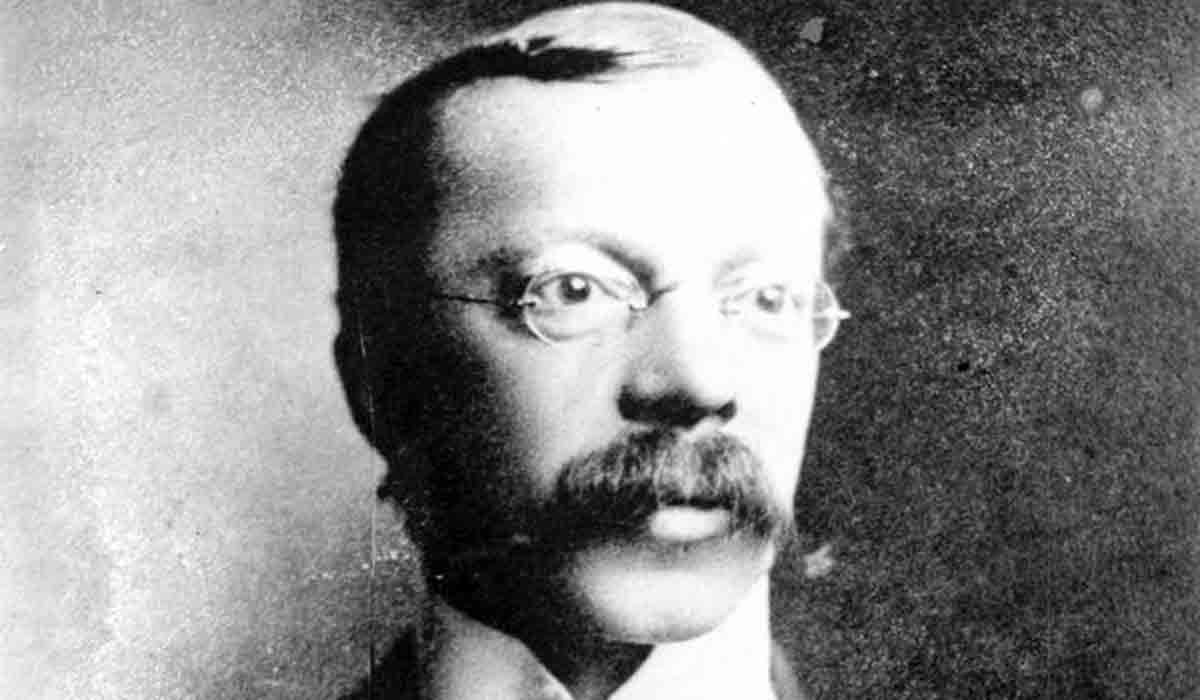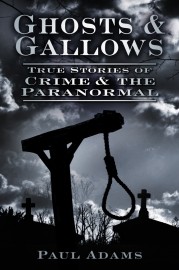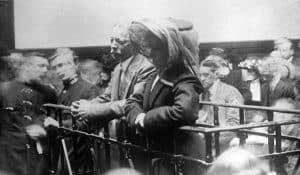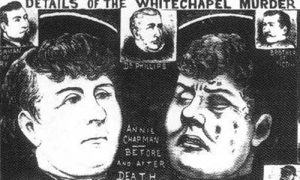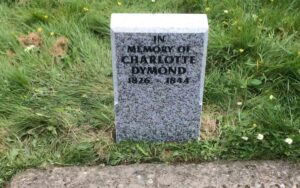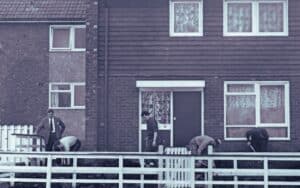PAUL ADAMS reveals the paranormal behind Dr Crippen’s ghost and some of Britain’s other infamous murderers in this exclusive chapter extract from “Ghosts and Gallows: True Stories of Crime and the Paranormal“
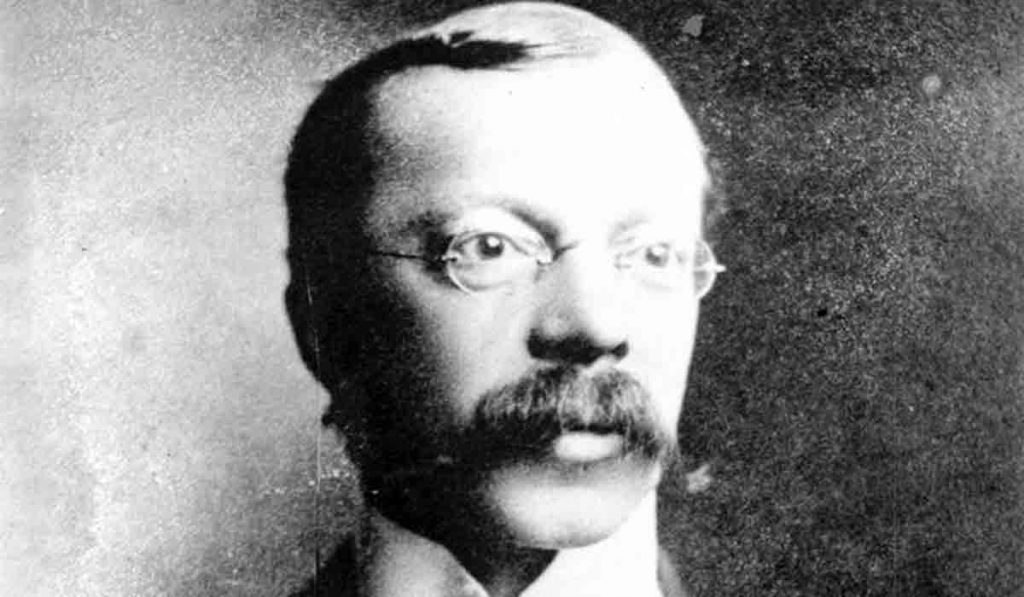
A glance through the published literature of British hauntings and haunted places quickly shows that where crime-related legends and stories feature some form of supernormal phenomena or haunting, it is most often the ghost of the unfortunate victim rather than the perpetrator that predominates.
However, this is not always the case as you will see from the following four real-life cases from the 20th century, each interesting to both the criminologist and the paranormal researcher alike.
Dr Crippen’s Ghost
Before it was reduced to rubble by enemy bombing during World War II, number 39 Hilldrop Crescent in London’s Kentish Town was the most noted murder house in the capital.
It was there at the beginning of February 1910 that American-born Hawley Harvey ‘Peter’ Crippen, a graduate of the Hospital College of Cleveland, Ohio, committed the wife murder that has made him one of the most famous names in the annals of British crime.
His story is well-known but remains a fascinating one.
Crippen had arrived in England in 1900 but when his qualifications were not recognised for him to practice medicine he was forced to take a lesser career working for the Munyon Patent Medicine Company.
His wife took in paying guests to help with the family finances.
Mrs Crippen, whose real name was Kunigunde Mackamotzki, was an aspiring but unsuccessful stage artist who went under a number of aliases including Cora Turner and Belle Elmore.
She was a forceful, dominant woman who ruled the Crippens’ home at Hilldrop Crescent with a firm hand. Her seemingly mild-mannered husband did much of the housework and, perhaps unsurprisingly, eventually elevated his secretary, 27-year-old Ethel Le Neve, to the status of mistress.
Mrs Crippen, who was treasurer of the Music Hall Ladies Guild, was last seen alive on 31 January 1910, when she and her husband invited two retired stage performers, Mr and Mrs Martinetti, to dinner.
Two days later, the Ladies Guild received Cora Crippen’s resignation – due to her need to return to American to nurse a sick relative – and Dr Crippen quickly moved Ethel Le Neve into 39 Hilldrop Crescent where she was soon openly wearing Mrs Crippen’s jewellery.
Not long after, Crippen was breaking the news to friends and relatives that his wife had died of pneumonia in California.
Most were convinced by the little doctor’s story, but a family friend was unhappy enough to take her suspicions to the police, with the result that Chief Inspector Walter Dew of Scotland Yard paid Crippen a visit.
Dew found nothing untoward at Hilldrop Crescent and seemed satisfied with the doctor’s explanations.
Despite this the experience was enough to convince Crippen and his lover that it was too dangerous to remain in London.
He shaved off his moustache, dressed Ethel Le Neve as a boy, and the couple fled the country to Antwerp, where they boarded the SS Montrose bound for Quebec.
News of Crippen’s flight reached Walter Dew at Scotland Yard and he returned to Hilldrop Cresent.
In the cellar, officers unearthed parts of a human body wrapped in a woman’s underclothes and part of a pyjama jacket.
The well known Dr Bernard Spilsbury, on his first major case, found traces of hyoscine, a narcotic poison, in the remains as well as scar tissue that corresponded with an abdominal operation Mrs Crippen was known to have undergone.
This, together with the fact that the underwear and pyjamas belonged to Cora Crippen and her husband respectively, made the identity of the body obvious, despite the fact that the head, limbs and entire skeleton were missing.
All ports were notified and an arrest warrant was issued for the ‘London cellar murderer’ and his mistress.
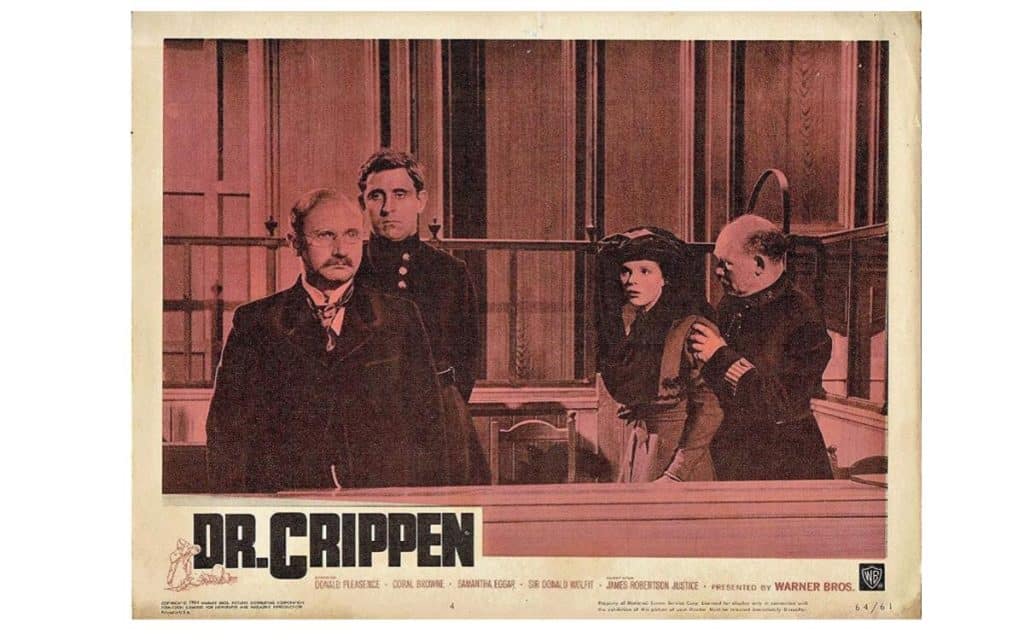
On board the SS Montrose just over a week later, the suspicions of the ship’s Captain Kendall that the fugitives appeared to be on board his vessel famously resulted in the wireless telegraph being used for the first time in a murder investigation.
Walter Dew was alerted and boarded a faster ship for Quebec. On 31 July, six months after the disappearance of Mrs Cora Crippen, her husband, who had written a suicide note during the voyage, was promptly arrested as he and his disguised mistress disembarked at Father Port.
Dr Crippen’s trial for murder began at the Old Bailey on 18 October and lasted four days. Found guilty Dr Crippen was hanged at Pentonville Prison at six o’clock on the morning of 23 November 1910.
He was 50 years of age. Ethel Le Neve, who was tried separately as an accessory after the fact, was acquitted and later moved to Australia.
Haunting of Hilldrop Crescent, Kentish Town
A traditional cyclical haunting is associated with the Crippen case although it may in fact stem from a single incident said to have taken place in the immediate aftermath of the trial and execution.
The Hilldrop Crescent that the Crippens knew has undergone extensive changes in the hundred years since that time and the Victorian villa where Cora Crippen lived and died, together with the houses either side, were demolished by post-war developers and replaced by a modern block of flats.
Close by number 32 was a plot of waste ground and a pond which have also disappeared.
It was here that the troubled doctor was known to have spent time walking at night in the weeks leading up to the dramatic events of 1910, and it is this particular location that developed a reputation as the place where his ghost returned on the night of 31 January, the anniversary of the likely date of the murder.
The haunting, which comprises a re-enactment of the disposal of the missing parts of Cora Crippen’s body, is said to have been witnessed by an unnamed psychical researcher during the week following Crippen’s execution.
During the course of several night-time vigils, the first just before midnight on the day that Crippen walked to the gallows, a vague shadowy form accompanied by a sensation of intense coldness, was seen moving across the waste ground adjoining Hilldrop Crescent.
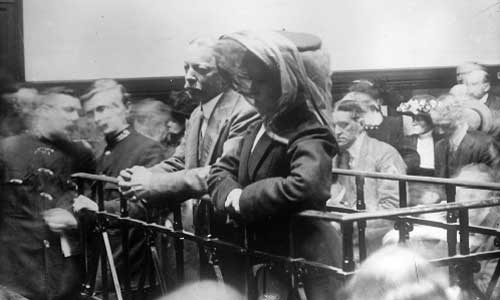
This developed into an apparition with staring eyes and a drooping moustache that resembled the murderer which carried a large bulky paper parcel under one arm.
The figure, surrounded by a palpable aura of sadness, moved into the shadows in the direction of the pond for a short time, after which it was seen returning, having seemingly left the parcel somewhere in the darkness.
It passed on and was observed for a few more seconds before suddenly vanishing. With the name of the witness lost to history, the ghost of Hilldrop Crescent is sadly rather unsatisfactory.
The haunting was first brought to light many years after the alleged event by Peter Underwood in his Haunted London (1973).
Underwood, a crime buff as well as a paranormalist, knew Fred Cavill, Crippen’s jailor at Bow Street Police Court, who described him as ‘a quiet, monkey-faced little man who never spoke except to ask the time, which he did twenty times a day’.
Whether Crippen did dispose of the missing parts of his wife’s body in this way will never be known.
That nothing has come to light over the years, during which time extensive building work has transformed the original Hilldrop Crescent, makes it unlikely, but not impossible.
Human Skull discovered by David Attenborough in Richmond, Surrey
In 2010, a human skull discovered in Richmond, Surrey by contractor’s digging foundations for an extension to the house of the well known naturalist Sir David Attenborough, was identified as being that of Mrs Julia Thomas, who was murdered in 1879 by her servant, 32-year-old Irishwoman Kate Webster.
Webster had disposed of parts of the body in the River Thames and it was alleged she had also sold jars of human dripping in a local public house. Her victim’s head was never recovered and it was long believed she had kept it in a black bag that she carried around with her.
If the haunting associated with such a noted case as that of Dr Crippen is unsatisfactory, then another slightly better, but nonetheless anecdotal, account is that of another poisoner, 43-year-old Ethel Lillie Major who was tried at Lincoln Assizes in November 1934 for the murder of her husband.
When Arthur Major, a lorry driver, married Ethel in 1918, he was unaware that his wife’s two-year-old sister Auriel was in fact her illegitimate daughter who was being raised by Ethel’s parents as their own.
Ethel had had an affair and fallen pregnant when she was twenty-four. In 1929, by which time the couple were living at Kirkby-on-Bain and had a child of their own, Arthur learnt through local gossip the truth about his real relationship to his young sister-in-law.
When Ethel refused to name Auriel’s father he became violent and she suffered for several years from his increasingly quarrelsome and abusive behaviour.
The Majors’ problems became well known in the local area, as did the fact that Arthur Major himself had taken a mistress, something that his wife found out about when love letters from the other woman started arriving at their house.
On 22 May 1934, Arthur Major became violently ill with food poisoning after his wife made him a meal of corned beef; he died two days later.
A local doctor certified the death as being due to ‘status epilepticus’ and Ethel Major began arranging the funeral, unaware that leftovers from her husband’s fatal meal had been given to a neighbour’s dog which had also died. Soon the police received an anonymous letter that the animal’s death was due to strychnine poisoning and the police intervened, halting the funeral in order to carry out a full post-mortem.
When it was found that Arthur Major’s body also contained strychnine his wife was questioned, and made the deadly mistake of implicating herself by denying any knowledge of strychnine as a cause of death before the subject was mentioned.
The police found that her father, a gamekeeper, owned a box of the poison to which his daughter had access, and Mrs Major was arrested.
The jury found her guilty of murder but their recommendation for clemency was ignored and a sentence of death was passed.
When Ethel Major, a tragic figure, stepped onto the gallows on 19 December 1934, despite a last hour appeal by telegram to the King by the Lord Mayor, she became the last person to be executed at Hull Prison, as well as the first woman that the well known executioner Albert Pierrepoint had the experience of hanging – on this occasion he was assisting his uncle, Thomas Pierrepoint.
Perhaps some aspect of the unhappiness of Mrs Major’s last years, as well as the final days she spent in the condemned cell, have resulted in her ghost being seen in Hull Prison on a number of occasions in the years following her execution.
The haunting is well known and despite their being no documented evidence, it was confirmed to me by Rob Nicholson, the prison historian at HMP Hull, that various prisoners have claimed to have seen Ethel Major in their cell at various times and subsequently had requested a transfer to another part of the prison.
As well as prison inmates, a former Prison Officer at one time reported sick after allegedly seeing her apparition.
Another woman, also a poisoner, who is said to haunt the prison where she was hanged is the former Blackpool housekeeper Louisa May Merrifield who was executed at Manchester’s Strangeways Prison in 1953 for the murder of her elderly employer, seventy-nine year-old, Sarah Ann Ricketts.
Louisa, in her mid-forties, was a scheming woman of dubious character.
Recently married to her third husband, Alfred Merrifield, who was nearly thirty years her senior, she had already served a prison sentence for ration book fraud when, on 12 March 1953, the couple were taken on by Mrs Ricketts as live-in housekeepers and companions at her bungalow in Devonshire Road, Blackpool.
A month later, Mrs Merrifield met a friend, a Mrs Brewer, and told her that they had moved in with an old lady who had since died and left them her property worth £3000.
Sarah Ricketts had indeed altered her will in the Merrifields’ favour, but at that particular point in time she was very much alive.
She obliged the couple by passing away three days later on 14 April.
Louisa attempted to get an undertaker to organise an immediate cremation but she was unsuccessful as Mrs Brewer had seen the notice – and the date – of Mrs Ricketts’ death in a local newspaper and, remembering the housekeeper’s boastful conversation, contacted the police.
A post-mortem showed that the old lady had died from poisoning by yellow phosphorus, a substance contained in a type of rat poison that Louisa Merrifield was known to have recently purchased.
The couple were arrested and appeared at the Manchester Assizes in July 1953 charged with murder. Despite the police being unable to find traces of poison at Mrs Rickett’s bungalow, Louisa was found guilty.
The jury was, however, unable to reach a verdict concerning her husband and the judge ordered a retrial at the next session of Assizes.
When the Attorney-General issued a fiat of nolle prosequi (unwilling to prosecute) he was released to inherit his half-share in Mrs Ricketts’ bungalow. He died in 1962 aged eighty, while his wife was hanged by Albert Pierrepoint and Robert ‘Jock’ Stewart on 18 September 1953.
Louisa Merrifield was one of only two women to be executed at Strangeways Prison during the 20th century; the other, 43-year-old Margaret Allen, went to her death four years before in January 1949.
No doubt the notoriety that the ‘Blackpool Poisoner’ obtained during her 11 day trial has meant that the female apparition alleged to have been seen in the prison on occasions over the years has been identified as her rather than that of Mrs Allen.
Reports of a short woman dressed in black walking on the landing near to the former condemned cell (later used as part of the clinic attached to the prison hospital) apparently reached a peak during the early 1980s, and in 1981 she was reportedly seen by two people – a prisoner and a hospital officer – collectively, accompanied by a sudden drop in temperature.
Another ghost associated with Strangeways, that of the apparition of a man carrying a briefcase, is thought to be former hangman John Ellis, a troubled man who committed suicide in 1932 after carrying out several executions at Manchester in the preceding two decades.
Let him have it, Chris!
In January 1953, a young delinquent, Derek Bentley, was hanged for his part in the shooting of a London policeman, Sidney Miles, at a warehouse in Croydon on 2 November the previous year.
Bentley, aged 19 and described as being ‘illiterate and educationally sub-normal’, had accompanied another teenage youth, sixteen year-old Christopher Craig, who modelled himself on American gangster figures like Al Capone and John Dillinger and hated the police.
Three days before their arrest at Croydon, Craig’s brother, Niven Craig aged 26, an armed robber, had been given a sentence of imprisonment at the Old Bailey.
Craig and Bentley’s attempted robbery went wrong when they were seen climbing over the factory gates and the police were called.
During a scuffle Derek Bentley was arrested but Craig climbed onto the roof of the building where he fired several shots, one of which hit PC Miles in the head, killing him instantly. The teenagers were tried at the Old Bailey in December 1952.
Bentley performed poorly in the witness box and together with his companion was found guilty of murder, despite it being Craig who had fired the fatal shot.
The real impetus behind Bentley’s notorious exclamation “Let him have it, Chris”, that he shouted while under arrest by officers and which featured prominently in the trial, has become one of the most debated sentences in British crime.
Due to his age, Christopher Craig was imprisoned while Bentley was sentenced to death, although the jury gave a recommendation for clemency. This was dismissed by the Court of Appeal and Bentley, amidst much public protest, kept a deadly appointment with Albert Pierrepoint and Harry Allen at Wandsworth Prison on 28 January 1953. Craig served ten years imprisonment and was released in 1963.
In the years that followed their son’s death, Bentley’s family lead a persistent campaign to clear his name.
It was not until 1993 that Derek Bentley received a posthumous Royal Pardon for the death sentence passed 40 years before; the Court of Appeal finally quashed his murder conviction in 1998.
Before then his parents were reported to have left his bedroom at their house in Colliers Wood untouched and exactly as it was during the time that Bentley lived there.
It was also reported that the same room was haunted regularly by his presence: bedclothes were disturbed, the family heard footsteps, and his dog seemed to acknowledge his former owner, howling on occasion as if announcing his arrival.
Following the death of Bentley’s father William in 1974, it was alleged that their parish priest had in one instance fallen into a mediumistic trance and had channelled his dead son and spoken in his voice.
PAUL ADAMS is a Luton-based paranormal historian, writer and publisher. His latest is Written in Blood, a new examination of vampires and vampirism in British literature, film, music and television together with real-life cases including the Highgate Vampire, the Gorbals Vampire and Stoke-on-Trent’s Vampire of the Villas. Contains in-depth chapters on Stoker’s Dracula, the history of Hammer Films, Gothic and modern vampire literature and vampire-related murderers. Find out more at pauladamsauthor.co.uk Follow him @pauladamsauthor

